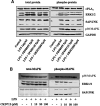(S)-tetrahydroisoquinoline alkaloid inhibits LPS-induced arachidonic acid release through downregulation of cPLA2 expression
- PMID: 24293010
- PMCID: PMC3887938
- DOI: 10.1007/s10059-013-0078-x
(S)-tetrahydroisoquinoline alkaloid inhibits LPS-induced arachidonic acid release through downregulation of cPLA2 expression
Abstract
Sepsis, a systemic inflammatory response syndrome, remains a potentially lethal condition. (S)-1-α-Naphthylmethyl-6,7-dihydroxy-1,2,3,4-tetrahydroisoquinoline (CKD712) is noted as a drug candidate for sepsis. Many studies have demonstrated its significant anti-inflammatory effects. Here we first examined whether CKD712 inhibits lipopolysaccharide (LPS)-induced arachidonic acid (AA) release in the RAW 264.7 mouse monocyte cell line, and subsequently, its inhibitory mechanisms. CKD712 reversed LPS-associated morphological changes in the RAW 264.7 cells, and inhibited LPS-induced release of AA in a concentrationdependent manner. The inhibition was apparently due to the diminished expression of a cytosolic form of phospholipase A2 (cPLA2) by CKD712, resulting from reduced NF-κB activation. Furthermore, CKD712 inhibited the activation of ERK1/2 and SAP/JNK, but not of p38 MAPK. CKD712 had no effect on the activity or phosphorylation of cPLA2 and on calcium influx. Our results collectively suggest that CKD712 inhibits LPS-induced AA release through the inhibition of a MAPKs/NF-κB pathway leading to reduced cPLA2 expression in RAW 264.7 cells.
Figures









References
-
- Barancik M, Bohacova V, Kvackajova J, Hudecova S, Krizanova O, Breier A. SB203580, a specific inhibitor of p38-MAPK pathway, is a new reversal agent of P-glycoprotein-mediated multidrug resistance. Eur J Pharm Sci. 2001;14:29–36. - PubMed
-
- Baron RM, Baron MJ, Perrella MA. Pathobiology of sepsis: are we still asking the same questions? Am J Respir Cell Mol Biol. 2006;34:129–134. - PubMed
-
- Casas J, Meana C, Esquinas E, Valdearcos M, Pindado J, Balsinde J, Balboa MA. Requirement of JNK-mediated phosphorylation for translocation of group IVA phospholipase A2 to phagosomes in human macrophages. J Immunol. 2009;183:2767–2774. - PubMed
-
- Clark JD, Schievella AR, Nalefski EA, Lin LL. Cytosolic phospholipase A2. J Lipid Mediat Cell Signal. 1995;12:83–117. - PubMed
Publication types
MeSH terms
Substances
LinkOut - more resources
Full Text Sources
Other Literature Sources
Research Materials
Miscellaneous

